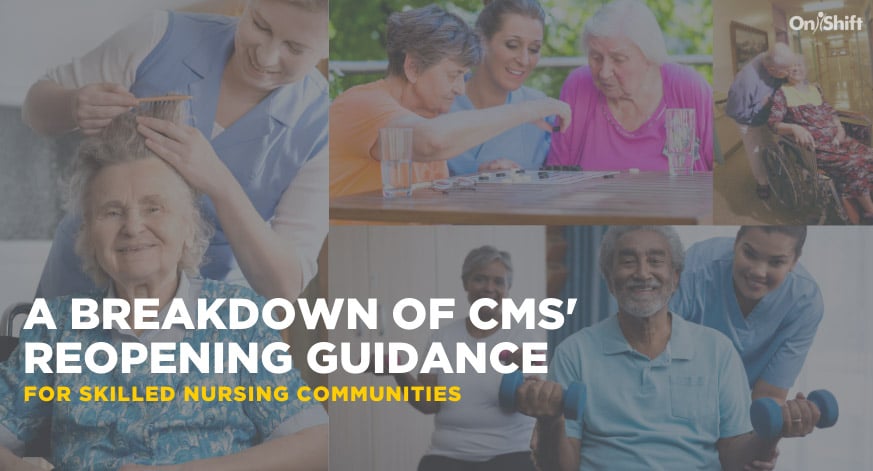June 9, 2020 | Lori Presser
June 9, 2020 | Lori Presser
 I’m so proud of how our local and national activities groups have stepped up to help senior care providers navigate the pandemic. They’ve made it a priority to produce continuing education content and share best practices so that we can all get through this together. That said, I thought you might find the information shared during a recent session hosted by the National Association of Activity Professionals (NAAP) valuable.
I’m so proud of how our local and national activities groups have stepped up to help senior care providers navigate the pandemic. They’ve made it a priority to produce continuing education content and share best practices so that we can all get through this together. That said, I thought you might find the information shared during a recent session hosted by the National Association of Activity Professionals (NAAP) valuable.
The live session was titled “Breaking down the Guidance from CMS to open SNFs across the United States.” Presenters Alisa Tagg, NAAP Association Director, and Vanessa Emm, NAAP Director of Operations, did a really nice job of making the Centers for Medicare & Services (CMS) community reopening guidance digestible and easy to understand.
The speakers prefaced their presentation by stressing that even though skilled nursing facilities are beginning to open, they are moving at a slower pace than the rest of the state. They said it’s also important to keep in mind that different facilities will enter these phases at different times depending on the severity of outbreaks of COVID-19 in their community.
These phases set forth by CMS in their Opening Up America Again plan were created to eliminate elevated risks for additional outbreaks of the novel coronavirus within communities, a sector that, as you well know, has proven to be severely impacted.
Each phase of the plan must be completed before moving onto the next phase. Phase 1 and 2 must be observed for a minimum of 14 days, and phase 3 must be observed for a minimum of 28 days. Before relaxing any restrictions and moving through the phases, facilities should ensure they have adequate staffing, access to testing, PPE and essential cleaning and disinfection supplies. Most importantly, communities should not advance through the phases until all staff and residents have been tested and the appropriate actions are taken based on the results.
CMS recommends that states continue to survey nursing homes that have had significant COVID-19 outbreaks throughout these various stages to ensure they are remaining vigilant and preventing further transmission.
The following actions are required during all three phases:
Here are the main differences and requirements for each phase:
Facilities may entire phase 1 with the proper precautions in place and no cases of COVID-19.
What is permitted during this phase:
What is still prohibited during this phase:
After 14 days of no new COVID-19 cases in the building, providers can move to phase 2.
What is permitted during this phase:
What is still prohibited during this phase:
If the facility has no new cases or COVID-19 positive residents for 28 days, providers can enter Phase 3.
What is permitted during this phase:
It will be a long road back to business as "normal" for senior care communities, but I'm confident we will get there by following the proper guidelines CMS has put in place. One thing is clear. The pandemic is shaping the future of long-term care and senior living. The industry has made strides in areas like infection control, individualized resident engagement programs and communication – both between management and staff and with the families we serve.
I’ve been particularly impressed at the way I’ve seen communities provide that person-centered care that we all strive for. The COVID-19 crisis has certainly brought to light just how important staffing is to achieve our mission and many are taking note of the significant challenges our industry faces in this area. Our staff are the backbone of our communities and we must continue to support them through this pandemic and beyond. I can’t wait to see the programs providers put in place post-pandemic to recruit, engage and retain these essential workers. And something tells me that technology will play a huge part in that.
Subscribe to the OnShift Blog
Recent Posts
Categories
About Lori Presser
Lori Presser, BSHA, CEAL,CDP, ACC, CMP, joined OnShift in February 2019 to help senior care operators find solutions to their most pressing workforce challenges. She offers 20 years of experience in the senior living industry, having held various positions in Operations, Marketing, Activities and Business Development. Lori is President of the Ohio Person-Centered Care Coalition, President of The Northeast Ohio Association of Activity Professionals, Former Vice President of The National Certification Council for Activity Professionals and a Volunteer Guardian in Summit County. She is also an advocate for seniors and senior living professionals providing person-centered care and person-centered employment opportunities.
See for yourself why thousands of providers rely on OnShift’s innovative software for recruitment, hiring, workforce management, pay and engagement. Request your personalized demo today.
